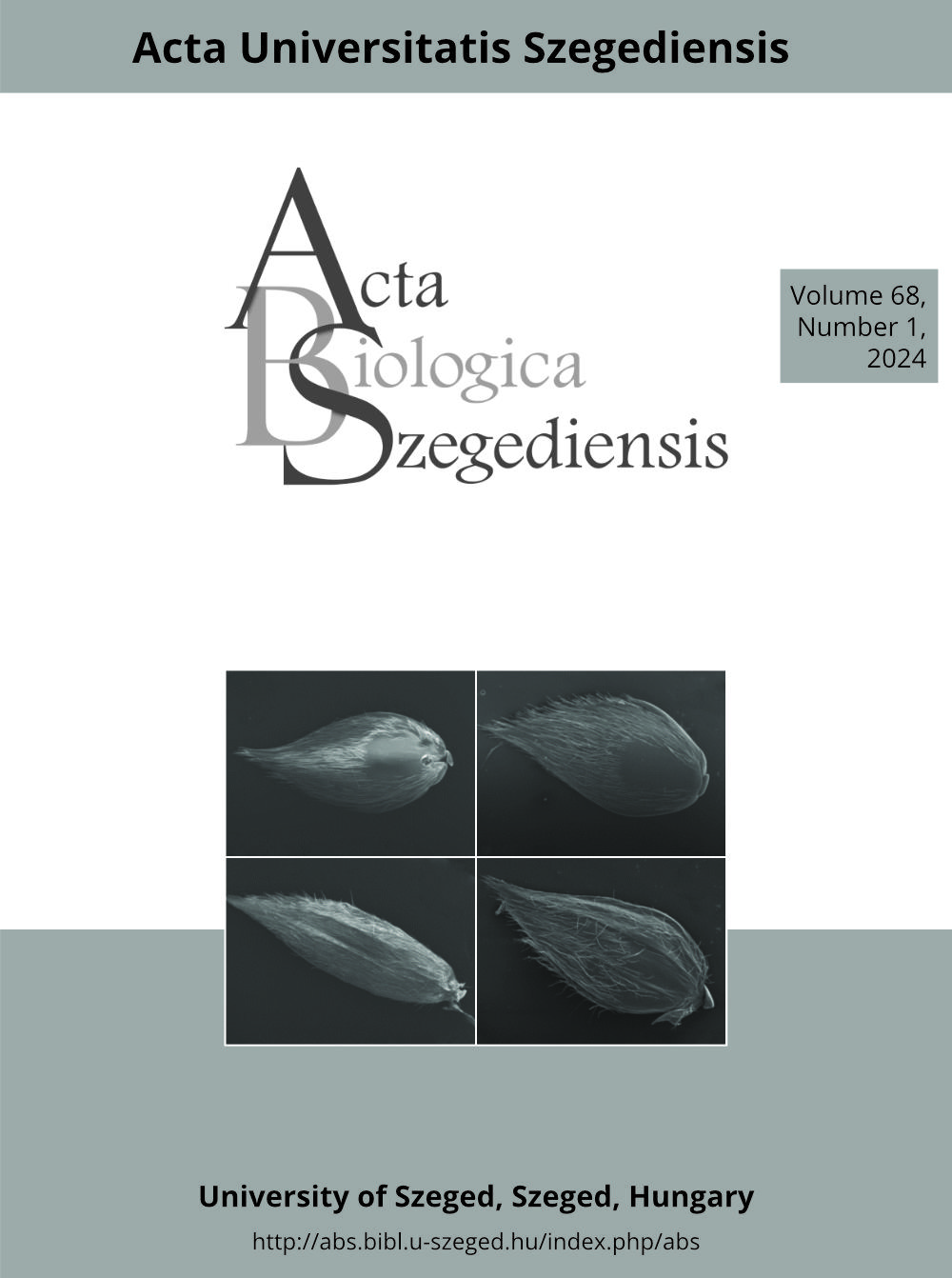Investigation of aflatoxin production in three different Aspergillus species
DOI:
https://doi.org/10.14232/abs.2024.1.38-45Keywords:
Aspergillus parasiticus, aflatoxin, cultivation conditionsAbstract
Mycotoxins are secondary metabolites produced by molds, particularly by Aspergillus species, with their production influenced by various environmental and other factors. The growth and physiology of fungi are affected by factors such as temperature, water activity, and time. The aim of this study was to identify the best aflatoxin-producing Aspergillus strain among known mycotoxigenic species and isolates and to fine-tune specific cultivation conditions to achieve the highest aflatoxin yield. For this purpose, aflatoxin production was tested in isolates belonging to Aspergillus pseudotamarii (1), A. minisclerotigenes (1), and A. parasiticus (3). The presence and quantity of aflatoxins were determined by HPLC with fluorescence detection. Among the examined strains, A. parasiticus SZMC 22361 proved to be the most suitable toxin-producing strain. Our findings suggest that the optimal conditions for aflatoxin production by this isolate on a maize substrate involve a water-to-substrate ratio of 1:1 (m/m) over a production period of approximately one week.
Downloads
References
Akinola SA, Ateba CN, Mwanza M (2021) Behaviour of Aspergillus parasiticus in aflatoxin production as influenced by storage parameters using response surface methodology approach. Int J Food Microbiol 357:109369.
Baranyi N, Kocsubé S, Szekeres A, Raghavan A, Narendran V, Vágvölgyi C, Panneer Selvam K, Babu Singh YR, Kredics L, Varga J, Manikandan P (2013) Keratitis caused by Aspergillus pseudotamarii. Med Mycol Case Rep 2:91-94.
Bhat R, Rai RV, Karim AA (2010) Mycotoxins in food and feed: present status and future concerns. Compr Rev Food Sci Food Saf 9:57-81.
Bilotti LG, Fernández Pinto VE, Vaamonde G (2000) Afla-toxin production in three selected samples of triticale, wheat and rye grown in Argentina. J Sci Food Agric 80:1981-1984.
Bosch J, Varliero G, Hallsworth JE, Dallas TD, Hopkins D, Frey B, Kong W, Lebre P, Makhalanyane TP, Cowan DA (2021) Microbial anhydrobiosis. Environ Microbiol 23:6377-6390.
Bukhari SH, Asghar MA, Ahmed F, Jabeen S (2023) The production of aflatoxin B1 by Aspergillus parasiticus in peanuts and walnuts under the influence of controlled temperature and water activity. Int J Food Engin 19:551-560.
Commission Regulation (EU) 1881/2006 (2006)Setting maximum levels for certain contaminants in foodstuffs. OJEU 364:5-24.
Commission Regulation (EU) 401/2006 (2006) Laying down the methods of sampling and analysis for the of-ficial control of the levels of mycotoxins in foodstuffs. OJ EU 70 :12-34 .
Davis ND, Diener UL (1968) Growth and aflatoxin production by Aspergillus parasiticus from various carbon sources. Appl Microbiol 16:158-159.
Ehrlich KC, Montalbano BG, Cotty PJ (2003) Sequence comparison of aflR from different Aspergillus species provides evidence for variability in regulation of afla-toxin production. Fung Genet Biol 38:63-74.
Endre, G, Hegedüs, Z, Turbat, A, Škrbić, B, Vágvölgyi, C, Szekeres, A (2019) Separation and purification of aflatoxins by centrifugal partition chromatography. Toxins 11:309.
Endre G, Nagy BE, Hercegfalvi D, Kasuba C, Vágvölgyi C, Szekeres A (2023) Scale-up of aflatoxin purification by centrifugal partition chromatography. Toxins 15:178.
Frisvad JC, Hubka V, Ezekiel CN, Hong S-B, Nováková A, Chen AJ, Arzanlou M, Larsen TO, Sklenář F, Mahakarnchanakul W, Samson R A, Houbraken J (2019) Taxonomy of Aspergillus section Flavi and their production of aflatoxins, ochratoxins and other mycotoxins. Stud Mycol 93:1-63.
Gallo A, Solfrizzo M, Epifani F, Panzarini G, Perrone G (2016) Effect of temperature and water activity on gene expression and aflatoxin biosynthesis in Aspergillus flavuson almond medium. Int J Food Microbiol 217:162-169.
Geiser DM, Pitt JI, Taylor JW (1998) Cryptic speciation and recombination in the aflatoxin-producing fungus Aspergillus flavus. PNAS USA 95:388-393.
Geiser DM, Dorner JW, Horn BW, Taylor JW (2000) The phylogenetics of mycotoxin and sclerotium production in Aspergillus flavus and Aspergillus oryzae. Fung Genet Biol 31:169-179.
Gizachew D, Chang C-H, Szonyi B, De La Torre S, Ting W-TE (2019) Aflatoxin B1 (AFB1) production by Asper-gillus flavus and Aspergillus parasiticus on ground Nyjer seeds: The effect of water activity and temperature. International J Food Microbiol 296:8-13.
Gqaleni N, Smith JE, Lacey J, Gettinby G (1997) Effects of temperature, water activity, and incubation time on production of aflatoxins and cyclopiazonic acid by an isolate of Aspergillus flavus in surface agar culture. Appl Environ Microbiol 63:1048-1053.
Hallsworth JE (2022) Water is a preservative of microbes. Microb Biotechnol 15:191-214.
Shotwell OL, Goulden ML, Hesseltine CW, Dickens JW, Kwolek WF (1980) Aflatoxin: distribution in contaminated corn plants. Cereal Chem 57:206-208.
Hussein H (2001) Toxicity, metabolism, and impact of mycotoxins on humans and animals. Toxicology 167:101-134.
Ito Y, Peterson SW, Wicklow DT, Goto T (2001) Aspergillus pseudotamarii, a new aflatoxin producing species in Aspergillus section Flavi. Mycol Res 105:233-239.
Klich MA (2007) Aspergillus flavus: the major producer of aflatoxin. Mol Plant Pathol 8:713-722.
Lahouar A, Marin S, Crespo-Sempere A, Saïd S, Sanchis V (2016) Effects of temperature, water activity and incubation time on fungal growth and aflatoxin B1 production by toxinogenic Aspergillus flavus isolates on sorghum seeds. Rev Argent Microbiol 48:78-85.
Liu X, Guan X, Xing F, Lv C, Dai X, Liu Y (2017) Effect of water activity and temperature on the growth of As-pergillus flavus, the expression of aflatoxin biosynthetic genes and aflatoxin production in shelled peanuts. Food Control 82:325-332.
Lloyd KG (2021) Time as a microbial resource. Environ Microbiol Rep 13:18-21.
Magan N, Hope R, Cairns V, Aldred D (2003) Post-harvest fungal ecology: Impact of fungal growth and mycotoxin accumulation in stored grain. In Xu X, Bailey JA, Cooke BM (Eds), Epidemiology of Mycotoxin Producing Fungi: Under the aegis of COST Action 835 ‘Agriculturally Important Toxigenic Fungi 1998-2003’, EU project (QLK 1-CT-1998–01380). Springer Netherlands, Dordrecht.
Peraica M, Radić B, Lucić A, Pavlović M (1999) Toxic effects of mycotoxins in humans. Bull WHO 77:754-766.
Pildain MB, Frisvad JC, Vaamonde G, Cabral D, Varga J, Samson R A (2008) Two novel aflatoxin-producing Aspergillus species from Argentinean peanuts. Int J Syst Evol Microbiol 58:725-735.
Probst C, Callicot K, Cotty PJ (2012) Deadly strains of Kenyan Aspergillus are distinct from other aflatoxin producers. Eur J Plant Pathol 132:419-429.
Rakk D, Kukolya J, Škrbić BD, Vágvölgyi C, Varga M, Szekeres A (2023) Advantages of multiplexing ability of the Orbitrap mass analyzer in the multi-mycotoxin analysis. Toxins 15:134.
Romero Donato CJ, Cendoya E, Demonte LD, Repetti MR, Chulze SN, Ramirez ML (2022) Influence of abiotic factors (water activity and temperature) on growth and aflatoxin production by Aspergillus flavus in a chickpea-based medium. Int J Food Microbiol 379:109841.
Schincaglia A, Aspromonte J, Franchina FA, Chenet T, Pasti L, Cavazzini A, Purcaro G, Beccaria M (2023) Current developments of analytical methodologies for aflatoxins’ determination in food during the last decade (2013–2022), with a particular focus on nuts and nut products. Foods 12:527.
Schmidt-Heydt M, Abdel-Hadi A, Magan N, Geisen R (2009) Complex regulation of the aflatoxin biosynthesis gene cluster of Aspergillus flavus in relation to various com-binations of water activity and temperature. Int J Food Microbiol 135:231-237.
Soliman KM (2002) Incidence, level, and behavior of afla-toxins during coffee bean roasting and decaffeination. J Agric Food Chem 50:7477-7481.
Steiner D, Bartók T, Sulyok M, Szekeres A, Varga M, Horváth L, Rost H (2024) Global perspectives on mycotoxin reference materials (Part I): insights from multi-supplier comparison study including aflatoxin B1, deoxynivalenol and zearalenone. Toxins 16:397.
Tran-Dinh N, Pitt JI, Carter DA (1999) Molecular genotype analysis of natural toxigenic and nontoxigenic isolates of Aspergillus flavus and A. parasiticus. Mycol Res 103:1485 -149 0 .
Varga J, Frisvad J, Samson R (2009) A reappraisal of fungi producing aflatoxins. World Mycotoxin J 2:263-277.
Varga J, Frisvad JC, Samson R A (2011) Two new aflatoxin producing species, and an overview of Aspergillus section Flavi. Stud Mycol 69:57-80.
Wang X, Subko K, Kildgaard S, Frisvad JC, Larsen TO (2021) Mass spectrometry-based network analysis reveals new insights into the chemodiversity of 28 species in Aspergillus section Flavi. Front Fung Biol 2:719420
Downloads
Published
How to Cite
Issue
Section
Funding data
-
Hungarian Scientific Research Fund
Grant numbers OTKA K-139312 -
Nemzeti Kutatási, Fejlesztési és Innovaciós Alap
Grant numbers 2021-1.2.4-TÉT-2021-00039








